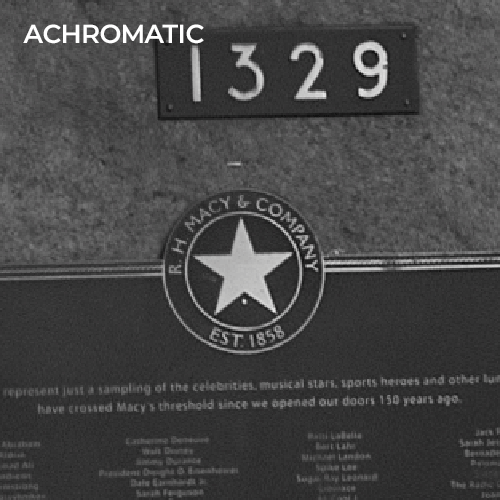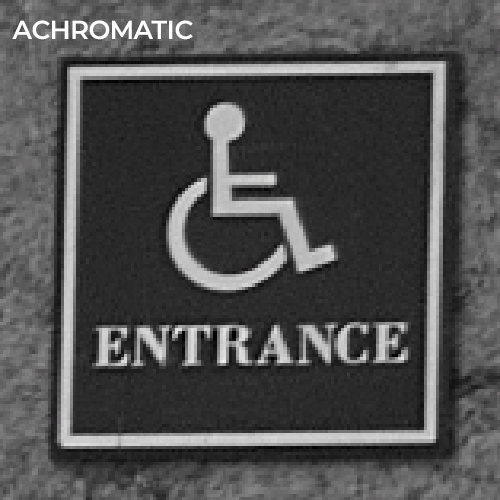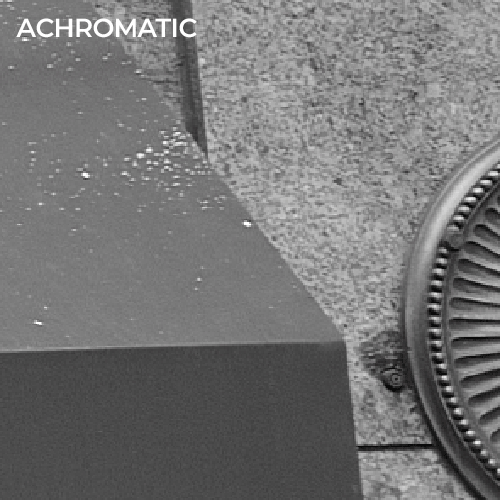Gear Testing, Hardware, Phase One, Tech Tips
Black & White Comparison – Phase One’s IQ3 100MP Achromatic vs IQ3 100 MP Trichromatic
For many photographers looking to create Black & White imagery, simply desaturating a color image provides all the detail, contrast, and quality necessary—with the added benefit of carrying around just one digital back for both color and B+W.

In this 400% zoom from our test image, the small text under the star is significantly clearer and more legible with the Achromatic back.
But for the serious B+W aficionado, every pixel matters. This is where Phase One’s Achromatic digital backs come in. Not only is the image clearer and “purer,” but there is a more film-like quality to the grain. This all comes down to how the achromatic sensor receives light versus a color sensor.
To put it extremely simply, a color image is created by filtering the light coming in— exposing some pixels to only red light, others to only green, and others to only blue. Without diving into the math too deeply, this effectively means that no individual pixel receives more than about 20% of the incoming light. The Achromatic sensor does away with the color filtering, and exposes each pixel to 100% of the light, creating some distinct difference in the final image.
For starters, the base ISO of the IQ3 100MP Trichromatic sensor is ISO 35, while the Achromatic’s is ISO 200. This is a direct result of the sensor exposing each pixel to more light. You’re getting two and a half “free” stops of ISO – at ISO 200 the Achromatic has even cleaner shadows than the Trichromatic at ISO 35. At higher ISOs the difference is even more exaggerated; the Achromatic produces a strong grain at ISO 51,200 but the grain is free of any clumping or banding.

This crop illustrates the additional information gathered by the Achromatic sensor, with the serifs on the letters R and N almost completely missing in the Trichromatic version.
Secondly, fine detail is clearer, because the image is being exposed evenly across adjacent pixels. For example, if you have a small detail of your subject that’s red, and that detail is exposed across 6 adjacent pixels, only 2 of those pixels are filtered for red light, and must be interpolated for the other 4 pixels. Since the Achromatic sensor is exposing all of those adjacent pixels evenly, the detail will be sharper in those areas.
And third, because there is an inherent geometric pattern to the color filtering in the Trichromatic back, the grain can sometimes appear slightly “clumpy.” It should be noted that Phase One’s Trichromatic sensor provides a far better grain than the vast majority of digital cameras on the market, but the Achromatic’s sensor’s homogeneous response to light produces a grain that’s far more “organic” and film-like.
To give a real-world example of these differences, DT did a head-to-head test of the IQ3 100MP Achromatic and the IQ3 100MP Trichromatic. This was done on a tripod with mirror up using the Schneider 45LS Blue Ring at f/8. We’ve provided the the Raw files for download, as well as a layered TIFF (“DTx13_003 vs DTx13_004 – Aligned in PS – Layered.tif”) with the Achromatic and Trichromatic images set up to turn off and on to make the subtle but real differences more readily apparent. Simply fill out the form below to receive the files.
With the release of Phase One’s all-new IQ4 150MP Achromatic with the Infinity Platform, we see similar differences in B+W response between it and the IQ4 150MP color back, and as we do more in-house testing we will post those results here as well.

The flat, even slab of stone on the left shows the difference in each sensor’s grain, highlighting the finer, more “film-like” grain of the Achromatic sensor. Also note the detail of the bolt socket in the lower right side of the image.
One additional topic to mention is that the Achromatic allows superior infrared shooting capabilities (if you order it with a clear internal filter vs. the standard IR-cut filter, While we can convert any Phase One back to be IR-capable (by removing this IR-cut filter) this has two problems:
- It negatively affects the use of the back for standard color imaging; while you can add an IR-block filter in front of the lens this will create a slight color shift at the edge of the frame.
- Only the red channel carries meaningful response to near-IR light, so only 1 out of 4 pixels are responding to the IR light. Detail and shadow smoothness suffer as a result.
Of course an IQ4 150MP color back without an IR filter is still a fantastic IR camera. But with an Achromatic back neither of the two above challenges apply and, as a result, a Phase One IQ4 Achromatic is the world’s best infrared camera and the closest match to historical infrared film.
Right now is a great time to invest in an Achromatic digital back, with deals on IQ2 and IQ3 models, as well as the incredible IQ4 150 Achromatic. If you’d like to learn more, contact us for pricing or to set up an in-person demo by clicking here.
Download Raw Files

